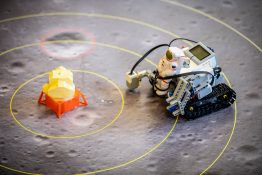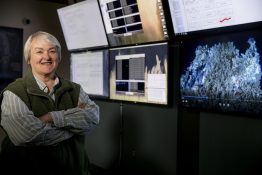UW Northwest Earth and Space Sciences Pipeline marks the 50th anniversary of the Apollo moon landing with a cool challenge for elementary, middle and high school students.
Read more at UW News »One year into the mission, autonomous ocean robots set a record in survey of Antarctic ice shelf
A team of ocean robots deployed in January 2018 have, over the past year, been the first self-guided ocean robots to successfully travel under an ice sheet and return to report long-term observations. Beyond mere survival, the robotic mission — a partnership between the University of Washington’s College of the Environment, the UW Applied Physics Laboratory, the Lamont-Doherty Earth Observatory of Columbia University, the Korean Polar Research Institute and Paul G.
Read more at UW News »UW glaciologist gets first look at NASA’s new measurements of ice sheet elevation
Less than three months into its mission, NASA’s Ice, Cloud and land Elevation Satellite-2, or ICESat-2, is already exceeding scientists’ expectations. The satellite is measuring the height of sea ice to within an inch, tracing the terrain of previously unmapped Antarctic valleys and measuring other interesting features in our planet’s elevation. Benjamin Smith, a glaciologist with the University of Washington and member of the ICESat-2 science team, shared the first look at the satellite’s performance at the American Geophysical Union’s annual meeting Dec.
Read more at UW Today »Q&A with Harold Tobin, director of the Pacific Northwest Seismic Network
Earthquake expert Harold Tobin joined the UW this fall as professor of Earth and space sciences and director of the Pacific Northwest Seismic Network. While he comes from a faculty position at the University of Wisconsin, he’s no stranger to the risks posed by offshore faults like the Cascadia Subduction Zone, the source of our “big one.” UW News sat down with Tobin to learn a bit more about his research, experience and plans for the UW-based Pacific Northwest Seismic Network, a coalition among the U.S.
Read more at UW Today »NSF awards contract to carry OOI into the next decade and beyond
The National Science Foundation announced that it has awarded a coalition of academic and oceanographic research organizations a five-year, $220 million contract to operate and maintain the Ocean Observatories Initiative. The coalition, led by the Woods Hole Oceanographic Institution, with direction from the NSF and guidance from the OOI Facilities Board, will include the University of Washington, Oregon State University and Rutgers, The State University of New Jersey.
Read more at UW Today »





